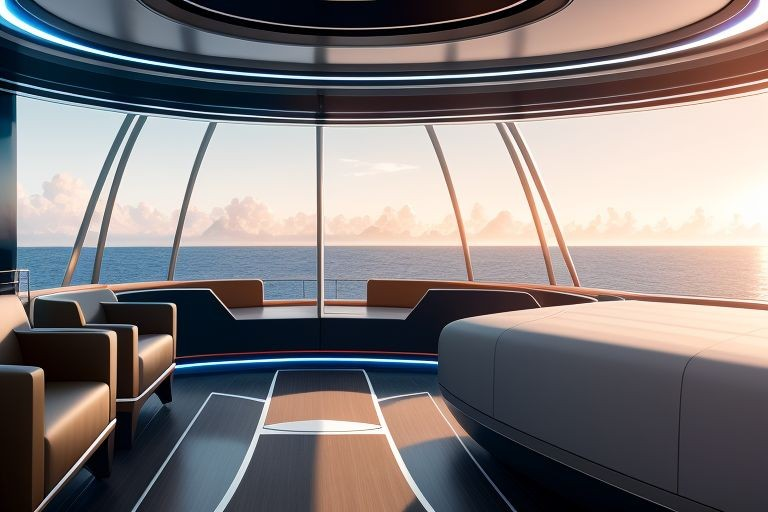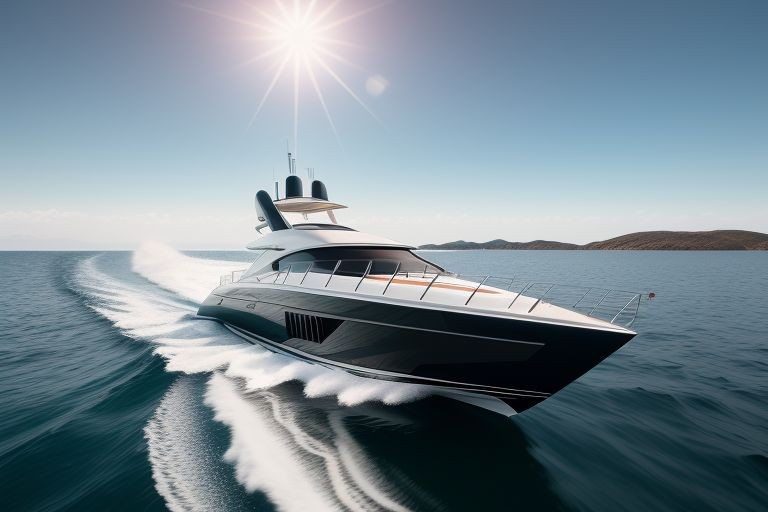The Quest for Mega Speed in Mega Yachts Part 1
Megayacht of the future?
I get calls quite often from people in the boating press asking me for my predictions concerning megayacht mega trends. Frequently during interviews the question arises “What will be the megayacht of the future?”
To be totally honest with you, when being interviewed by one of the big time boating magazines, I’m expected to be totally professional and give yacht designer type answers. So I put on my yacht designer’s hat and prepare to answer questions in yacht designer techno-talk. My voice drops a few octaves and I assume my “William F. Buckley posture”, leaning way back in my chair with a heavy list to starboard teetering on the brink of disaster. By the way, I suspect that part of Mr. Buckley’s popularity stems from people watching Firing Line in anticipation of the big moment when Mr. Buckley’s CG exceeds the boundaries of his chair legs and he, very slowly at first, starts keeling over without missing a polysyllabic word on his way down to the floor. What a great T.V. moment that would be!
Anyway, like I said, during official interviews I wear my yacht designer’s hat. In this column however, I can sport my writer’s hat, and I am lucky enough to have the freedom to say things I wouldn’t or couldn’t say in an interview (for your information, a power yacht designer’s hat is a beanie with a four bladed prop on it. A sailboat designer’s hat is fitted with a full rigged mast, boom and sails and clears the wearer’s sinuses every time he jibes. A writer’s hat is modeled after the tip of a pencil – sort of like a dunce cap). I’ve already written some about trends in megayachts in past articles. When viewed strictly from a hedonistic (excuse me I forgot I’m wearing my writer’s hat now and don’t have to use William F. Buckley-type words) point of view, the megayacht has about maxed out.
Modern yachts are being festooned with everything from laser lit Technicolor waterfalls to handrails that glow in the dark. Stuff like onyx, whale scrotum covered barstools, gold fixtures, inside and outside whirlpool tubs, barbeques, lobster tanks, soda fountains, hair dressing salons, automobiles, mini-subs, jet skis, hobie cats, carpathian, burl, computer controlled ambient lighting, sculpture, double satcoms, crystal, original artwork, audio visual systems and mink sculptured carpeting is being done to mega death. Mega styling runs the gamut from the good, the bad and the ugly. Many yachts would look at home rendezvousing with the Starship Enterprise orbiting the planet Vulcan! No, when it comes to sybaritic (sorry -- there’s another one of those words again) accoutrements (I can’t stop!) and styling, it’s very difficult to come up with something new.
Need for Speed
But there is one feature of large yachts that will always be new. SPEED!! Big speed! Blow the sunglasses off your head speed. Overtaking Cigarrete speed. Straighten your hair speed. Blow your bikini top off speed. Speed that, only a few years ago, boats in the 40’ range could attain. Speed will never be dated or overused. The quest for ever higher speeds in large yachts is the big story today and will be the big story of the future. Just a few years ago, a fast large yacht (for the record let’s call a “large yacht” anything over 100’ though I’m sure this will upset some people with 150’ers) did 20 knots max. Twenty knots in any kind of boat is respectable speed. Twenty knots (23 mph) on the water is pretty darn fast. These days many large, fast yachts slow cruise at 20 knots and top 30 knots.
Large, fast yachts have always been around but they were extremely rare, built for the odd sheikh or king there. Palmer Johnson was one of the pioneers of mega speed. They built the King of Spain’s 100’ “FORTUNA”, which, powered with two diesels totaling 2900 HP and a single gas turbine putting out another 4500 HP (total 7400 HP), did an astounding 50 knots in 1979 and to this day is one of if not the fastest megas in the world. Then there’s “SHERGAR” at 153’ powered by an unbelievable 16,990 HP which attains 45 knots. While these two vessels stand out as high-water marks in mega speed, it’s safe to predict that yachts, such as these, will become more common in the future.
It’s now time for me to don my yacht designer’s hat to put forth some technical mega info. Please try to stay awake. The speed/power curve for a fast yacht looks something like Bob Hope’s nose in profile. It starts out rather flat but gets ever steeper as speed is increased until it is nearly vertical. True, higher speeds can always be attained by stuffing in more horsepower, however, the fact is that, above 30 knots, the large mono hull is fighting a losing battle.
The Scandinavians have already been this route. The coast of Norway looks like a paramecium under a microscope. It’s loaded with harbors, waterways and fjords. Waterways are the main transportation link between towns and cities and are serviced by high-speed ferries. They developed their mono hulls up to around 30 knots but their customers were demanding still more speed so Norwegian designers went to the catamaran configuration and thereafter to surface effect vessels for still higher speeds (100-foot, 100 passenger 42 knot ferries are common there.) The logical assumption would be that, in the near future, large motor yachts would go the catamaran or surface effect configuration.
Logic, however, does not always work with yachtsmen. Whether these parking lot shaped cats as SES craft will ever be accepted as true yachts remain a big question. Yachts have always been graceful and pointy at one end. Additionally, I wonder about the sea keeping capability of these ultrawide craft in the open sea. There’s simply too much flat impact area under the deck forward and when these vessels have to slow down for really big seas, they could be in trouble. There are hydrofoils, of course. But I doubt these will ever be integrated into the large yacht field with fixed foil drafts of maybe 15’ or with retracted foils that when stowed make a vessel appear as a giant, deranged, waterlogged praying mantis.
Other high speed large vessel oddities include surface piercers which, in effect, are huge platforms with two pontoon hulls per side stacked atop one another looking like two mating catamarans (maybe that’s where hobie cats come from?). The sea-keeping abilities of these vessels in the open sea is, in my opinion, also questionable. Lindsey Lord, who literally wrote the book on high-speed mono hull design, has developed a very promising concept which, in effect, combines the lift capabilities of a planning hull with the low resistance characteristics of a submerged hull.
Are you mega bored with all this technical stuff yet? The fact is, I needed to explain the state of the art in high-speed hulls in order that what will follow (when I again wear my writer’s hat) will make some sense.
The quest for mega speed. How far can it go? What’s the next bold step? Next Month, in the very exciting Spring Freeing Port Flap issue, I will suggest two outrageous mega directions for the large, fast yacht. Stay tuned. You won’t believe it!
(Reprinted with permission of Regina Fexas.)
If you would like to read more of Tom's pearls of wisdom, tune in next Friday -- "Fexas Friday."
Better yet, why not get a full dose of infectious Fexas whenever you need it -- and buy one of the volumes below. Better yet, why not buy all of them -- we call them the "Fexas Five." They will provide many evenings of fun reading (better than Netflix), and you'll make the widow Regina very happy knowing that Tom will live on with you the way most of us remember him.
Order 1, 2 or "The Fexas Five" --
To find the "Fexas Five" on Amazon, click here...
Tom Fexas (1941-2006) was one of the most influential yacht designers of the last quarter of the 20th century. With the narrow Wall Street commuters that were built in the 1920s and '30s always on the back of his mind, he wanted to design boats that were at once fast, comfortable, seaworthy and economical to operate. Over the years, he and his firm designed over 1,000 yachts for some of the most prestigious boat builders in the world, including Choey Lee, Palmer Johnson, Grand Banks, Mikelson Yachts, Burger, Abeking & Rasmussen and many others.
Even though toward the end of his career he only designed megayachts and superyachts, including the remarkably influential PJ "Time" in 1987, he is best remembered for his first major vessel in 1978 -- Midnight Lace -- which became a series of 44-52-footers. They were light, narrow, and fast with relatively small engines. He was also influential in the boating community because of the monthly column he wrote for Power and Motoryacht, which began in its very first issue in January 1985.



